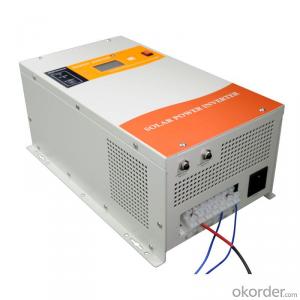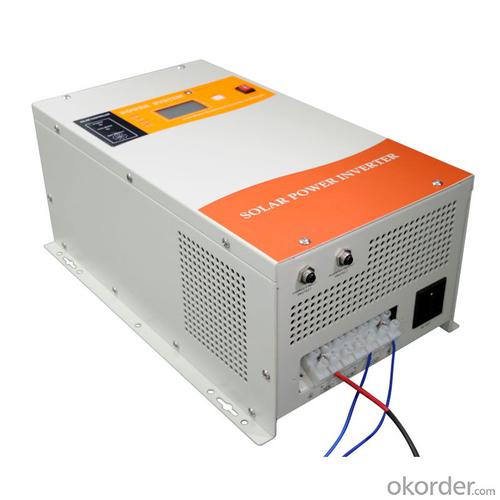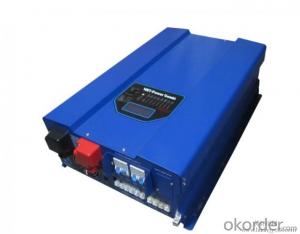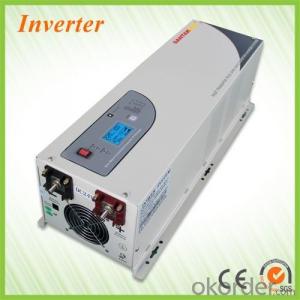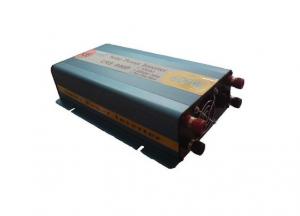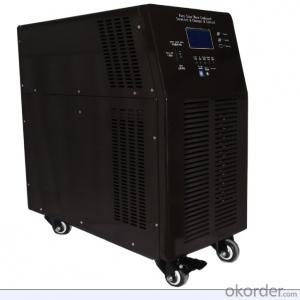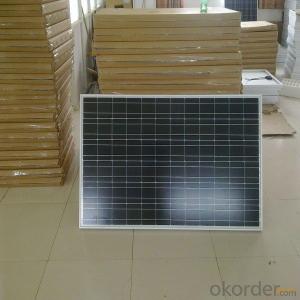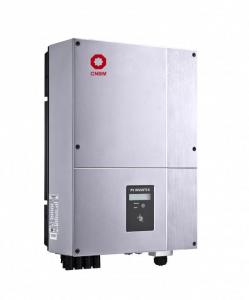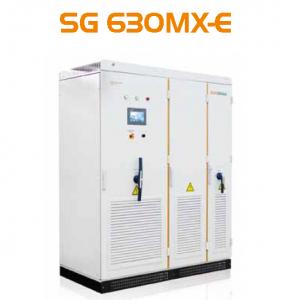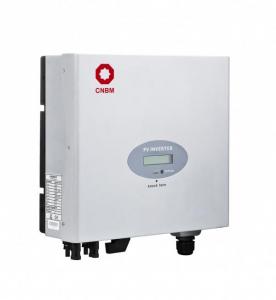2015 Hot Selling South Africa Solar Power Inverter made in China60a
- Loading Port:
- China main port
- Payment Terms:
- TT OR LC
- Min Order Qty:
- 50 pc
- Supply Capability:
- 1000 pc/month
OKorder Service Pledge
OKorder Financial Service
You Might Also Like
Features of Pure sine wave inverter :
For PV Energy Saving System
MPPT Charge with 40A Charge Controller
AC Output Voltage: 120Vac/230Vac 50Hz/60HZ Automatic
DC 24Vdc battery voltage
LCD Display screen
By-pass Input: AC grid or Generator
DC/AC Pure Sine Wave Low Frequency Inverter
9KVA Maximum Power Surge Rating for 20ms, Power 2HP Motor
Inbuilt Pure Copper Transformer
With RS232 & Remote Control Port
Sealed, GEL and flooded lead-acid batteries
IP21 Mental Case
Easy wiring
| MODEL | PV30-1KW | PV30-1.5KW | PV30-2KW | PV30-3KW | |||||
| Default Battery System Voltage | 12VDC | 24VDC | 12VDC | 24VDC | 12VDC | 24VDC | 12VDC | 24VDC | |
| INVERTER OUTPUT | Reted Power | 1.25KVA/1.0KW | 2KVA/1.5KW | 2.5KVA/2KW | 3.5KVA/3KW | ||||
| Surge Rating (20ms) | 3.0KVA | 4.5KVA | 6.0KVA | 9.0KVA | |||||
| Capable Of Starting Electric Motor | 1HP | 1HP | 1HP | 2HP | |||||
| Waveform | Pure sine wave/ same as input (bypass mode) | ||||||||
| Nominal Output Voltage RMS | 100V/110V/120VAC 220V/230V/240VAC(±10% RMS) | ||||||||
| Output Frequency | 5OHz/60Hz±0.3 Hz | ||||||||
| Inverter Efficiency(Peak) | >88% | ||||||||
| Line Mode Efficiency | >95% | ||||||||
| Power Factor | 0.8 | ||||||||
| Typical Transfer Time | 10ms(max) 10ms(max) | ||||||||
| AC INPUT | Voltage | 230VAC | |||||||
| Selectable Voltage Range | 96~132VAC 155~280VAC(For Personal Computers) | ||||||||
| Frequency Range | 50Hz/60Hz (Auto sensing) 40~80Hz | ||||||||
| BATTERY | Minimum Start Voltage | 10.OVDC /10.5VDC for12VDC mode (*2 for 24VDC, ) | |||||||
| Low Battery Alarm | 10.5VDC±0.3V for12VDC mode (*2 for 24VDC, ) | ||||||||
| Low Battery Cutoff | 10.0VDC±0.3V for12VDC mode (*2 for 24VDC, ) | ||||||||
| High Voltage Alarm | 16.0VDC±0.3V for12VDC mode (*2 for 24VDC, ) | ||||||||
| High Battery Voltage Recover | 15.5VDC±0.3V for12VDC mode (*2 for 24VDC, ) | ||||||||
| Idle Consumption-Search Mode | <25W when power saver on | ||||||||
| CHARGER | Output Voltage | Depends on battery tvpe | |||||||
| Charger AC Input Breaker Rrating | 10A | 30A | 30A | 30A | |||||
| Overcharge Protection S.D. | 15.7VDC for 12VDC mode (*2 for 24VDC mode) | ||||||||
| Maximum Charge Current | 35A | 20A | 45A | 25A | 65A | 35A | 75A | 45A | |
| BYPASS & PROTECTION | Input Voltage Waveform | Sine wave (grid or generator) | |||||||
| Nominal Input Frequency | 50Hz or 60Hz | ||||||||
| Overload Protection (SMPS Load) | Circuit breaker | ||||||||
| Output Short Circuit Protection | Circuit breaker | ||||||||
| Bypass Breaker Rating | 10A | 15A | 30A | 30A | |||||
| Max Bypass Current | 30Amp | ||||||||
| SOLAR CHARGER | Maximum PV Charge Current | 40A | |||||||
| DC Voltage | 12V/24V atuo work | ||||||||
| MPPT Range @ Operating Voltage | 15~55VDC | ||||||||
| Maximum PV Array Open Circuit Voltage | 55VDC | ||||||||
| Maximum Efficiency | >97% | ||||||||
| Standby Power Consumption | <2w | ||||||||
| MECHANICAL SPECIFICATIONS | Mounting | Wall mount | |||||||
| Dimensions (W*H*D) | 260*460*185mm | ||||||||
| Net Weight (Solar CHG) kg | 18.3 | 22 | 23.5 | 23 | 28 | 27 | |||
| Shipping Dimensions(W*H*D) | 350*570*300mm | ||||||||
| Shipping Weight (Solar CHG) kg | 21.9 | 24.8 | 26.5 | 25.6 | 31 | 30 | |||
| OTHER | Operation Temperature Range | 0°C to 40°C | |||||||
| Storage Temperature | -15°C to 60°C | ||||||||
| Audible Noise | 60dB MAX | ||||||||
| Display | LED+LCD | ||||||||
| Standard Warranty | 1 year | ||||||||
Warrenty
provides a 1~3 year limited warranty (“Warranty”) against defects in materials and workmanship for its Uninterruptible power supply, Power inverter/chargers, Solar charge controllers, Battery Products (“Product”).
The term of this Warranty begins on the Product(s) initial purchase date, or the date of receipt of the Product(s) by the end user, whichever is later. This must be indicated on the invoice, bill of sale, and/or warranty registration card submitted to MUST-Solar. This Warranty applies to the original MUST-Solar Product purchaser, and is transferable only if the Product remains installed in the original use location.
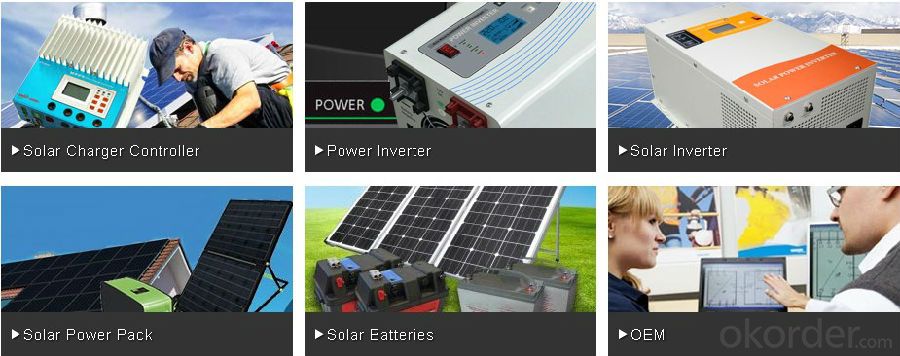
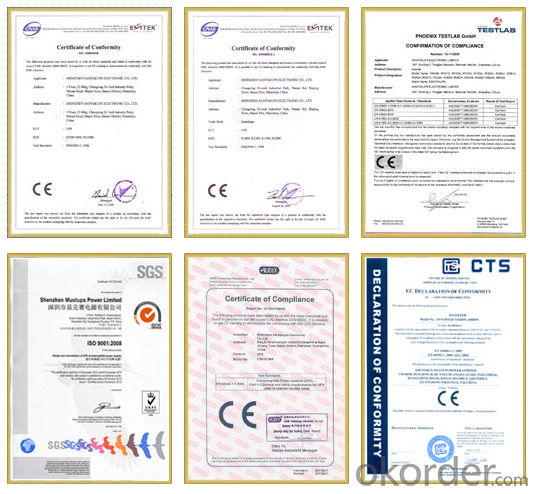
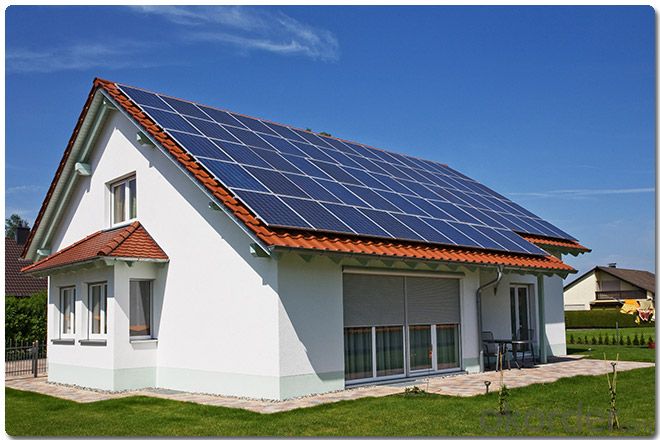
FAQ
1. How do I decide which system is right for me ?
For protection from long outages, include a generator or solar panels in your Must solar system. Shorter outages can be handled by a battery-only system.
2. Where my system will be installed ?
Must solar systems are usually wall-mounted near a home's main electrical (circuit breaker) panel.
3. How do I install my system ?
A must solar backup inverter is connected to a home electric system , we will supply detailed installation manual and videos for our customers .
4. How fast will my system respond to a power outage ?
Must solar inverters typically transfer to battery power in less than 16 milliseconds (less than 1/50th of a second).
- Q: Can a solar inverter be used with a backup power supply (UPS)?
- Yes, a solar inverter can be used with a backup power supply (UPS). The solar inverter can convert the DC power produced by solar panels into AC power, while the UPS can provide backup power in case of a utility grid failure. This combination allows for uninterrupted power supply, even during power outages.
- Q: Can a solar inverter be used with solar-powered streetlights?
- Yes, a solar inverter can be used with solar-powered streetlights. The solar inverter is responsible for converting the direct current (DC) produced by the solar panels into alternating current (AC) that can be used to power streetlights. This conversion allows the solar-powered streetlights to operate efficiently and effectively, utilizing the energy generated by the solar panels.
- Q: How does a solar inverter handle variations in ambient temperature?
- A solar inverter handles variations in ambient temperature by incorporating temperature compensation mechanisms. These mechanisms allow the inverter to adjust its operation and optimize performance based on the temperature conditions. By monitoring the temperature, the inverter can regulate voltage levels, adjust power outputs, and protect itself from overheating. This ensures that the inverter operates efficiently and reliably under different ambient temperature conditions.
- Q: Can a solar inverter be installed in a residential area?
- Yes, a solar inverter can be installed in a residential area. In fact, residential areas are common locations for solar installations, including the installation of solar inverters. These inverters are responsible for converting the direct current (DC) electricity generated by solar panels into alternating current (AC) electricity that can be used by household appliances and fed back into the electrical grid. Installing a solar inverter in a residential area allows homeowners to harness the power of solar energy and reduce their reliance on traditional electricity sources.
- Q: Can a solar inverter be used with different types of grounding systems?
- Yes, a solar inverter can be used with different types of grounding systems. Solar inverters are designed to be flexible and adaptable to various electrical systems and grounding configurations. They can be used with grounded, ungrounded, or impedance grounded systems, allowing for compatibility across different types of grounding systems.
- Q: What is the PV inverter starting voltage
- Photovoltaic inverter, also known as power regulator, according to the inverter in the use of photovoltaic power generation system can be divided into two kinds of independent power supply and grid. According to the waveform modulation method can be divided into square wave inverter, stepped wave inverter, sine wave inverter and modular three-phase inverter. For the inverter for the grid system, depending on whether the transformer can be divided into transformer-type inverter and transformer-free inverter.
- Q: How does a solar inverter handle low light conditions or cloudy days?
- A solar inverter handles low light conditions or cloudy days by adjusting its power output to match the available sunlight. It is designed to maximize the energy conversion efficiency even in low light situations, allowing for continuous power generation from the solar panels.
- Q: Can a solar inverter be used for three-phase power systems?
- Yes, a solar inverter can be used for three-phase power systems. There are specific three-phase solar inverters available in the market that are designed to convert DC power from solar panels into AC power for three-phase electrical grids. These inverters are capable of synchronizing with the grid and distributing power across all three phases efficiently.
- Q: How does the total harmonic distortion affect the performance of a solar inverter?
- Total harmonic distortion (THD) refers to the distortion in the waveform of an electrical signal caused by the presence of harmonics. In the case of a solar inverter, high levels of THD can negatively impact its performance. Excessive THD can lead to voltage and current waveform distortions, which can result in various issues such as reduced power quality, increased losses, and decreased efficiency of the solar inverter. These distortions can also affect the overall performance and lifespan of connected electrical devices, potentially leading to their malfunction or premature failure. Therefore, it is crucial to ensure that a solar inverter maintains low levels of THD to optimize its performance and minimize any adverse effects on the connected electrical systems.
- Q: What is the role of a solar inverter in a solar-powered electric fence?
- The role of a solar inverter in a solar-powered electric fence is to convert the direct current (DC) electricity generated by the solar panels into alternating current (AC) electricity that can be used by the electric fence system. The inverter ensures that the voltage and frequency of the electricity are compatible with the electric fence equipment, allowing it to function effectively and safely.
Send your message to us
2015 Hot Selling South Africa Solar Power Inverter made in China60a
- Loading Port:
- China main port
- Payment Terms:
- TT OR LC
- Min Order Qty:
- 50 pc
- Supply Capability:
- 1000 pc/month
OKorder Service Pledge
OKorder Financial Service
Similar products
Hot products
Hot Searches
Related keywords
